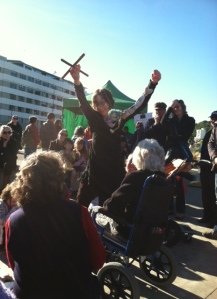I’m back from almost a month in New Zealand – first performing and then wandering around with Debbie. We had a great time.
When we reached Wellington, we had a nice dinner with a bunch of interesting people, organized by storyteller Judith Jones and her husband Tony. Among the great people we met that night was Anna Bailey, a puppeteer.
The next morning, at the farmer’s market on the Wellington waterfront, we sat on a bench and watched Anna give one of her shows, standing in front of an electrical junction box to shield her small stage from the gusts of wind swirling around the harbor. Children, mostly under seven or eight, sat on the pavement in front of her, with adults in a wider circle. Shoppers walked through her performance area, seemingly oblivious to the drama being acted out before them of a fisherman who catches a mermaid, then goes on a dance through the sea with her. The piece was about ten minutes long – no words, with recorded music providing backdrop. The piece, as many marionette shows are, was very lyrical and dream-like. There was a distinct narrative line, but it was up to the audience’s imagination to define that line – with no language, it was not explicit but implicit. At one point, she did roam the audience with her puppet, interacting with individual audience members, but mostly, Anna’s focus was inward, trusting the audience to come into her world, and not feeling compelled to go out and capture them, . She let the work speak for itself. Those of us who have done street performing know that there’s a choice you make about how you draw an audience to your performance – Anna, as seems to fit her personality, doesn’t seek an audience, she lets it come to her. I would say there were about fifteen of us who stayed through the whole piece. She had a little hat at the edge of the velvet blanket that served as the definition of the stage – people dropped coins in. I’d guess she made about $30 for her work.
Watching the show, looking at the venue, and thinking about the economics of the whole thing, got me thinking about the vagaries of being an artist. Anna’s work (String Bean Puppets) is not a get-rich-quick scheme. She is not very commercial – and my sense is that at this point in her work, she’s not interested in being commercial. Her work is small, not in the sense of importance, but in the scale that it works on – how many people it will reach, how much she earns, and how well known she would become doing it.
But really, most art is small. A good number of artists will, consciously or unconsciously, make sure it stays that way for them, either through eschewing commercial success, or happily shooting themselves in the foot if it gets near. (Believe me, I know…)And while some art deserves a bigger stage than it has, there is a lot of art that is about intimacy and the people in front of you at that moment Even the ones wandering by with a bag of leeks. Anna’s puppets are not large, and if the audience were more than a hundred people, something would be lost. Keeping it small is one way to insure a connection. Using a Jumbotron so that the people in the back of the stadium could see the mermaid dance would make it a vicarious experience. I suppose that television has the paradoxical opportunity to make it intimate – it’s just one person watching something shot in close-up. But the live performance is at the heart of it, and that, it seems to me, is destined to remain small.
So why do artists do it? The short answer is because they have to. They can’t help themselves. It gives their lives meaning. This causes havoc when you depend on it for your daily bread. As Lewis Hyde points out in his great book, The Gift, artists have a hard time living in a commodity culture in which you have to determine your worth and drive a bargain. Most artists first want to do their work, and will do it even if they aren’t getting paid well.
I’m thinking these things as both of my sons, Noah and Dylan, are trying to find where music fits in their lives, and have an ambivalence about the role of the market place in their art. Well, I still wrestle with that, too. I’ve often thought that some things I do for love, and some for money, and I’m just trying to get them to be a little bit closer to each other.
But like I said, a lot of really good art is small, and it helps to know that and still see its value; it’s still worth doing.







